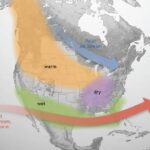By Jack Phillips and Joseph Lord
Dare County, a small coastal county nearly surrounded by the Atlantic Ocean in North Carolina, declared a state of emergency Sunday before the National Hurricane Center (NHC) announced that Category 3 Hurricane Erin had intensified back to a Category 4.
In an 11 p.m. update on Sunday, the NHC reported observing increased wind speeds near 115 mph, pushing Erin back up to a Category 4 hurricane. By 2 a.m., sustained wind speeds had increased further to 130 mph.
The county—which includes Roanoke Island, a peninsula jutting off the mainland of the state, and a long, thin coastal strip of islands in the Atlantic Ocean connected by roads—isn’t likely to be directly hit by the storm but could still be impacted by it, officials said.
“While Hurricane Erin is expected to stay well off our coast, the system will continue to increase in size and is forecast to bring life-threatening impacts to the Dare County coastline,” officials said in a statement announcing the state of emergency.
NOAA modelling on Sunday evening had Hurricane Erin on track to grow in size and intensify, according to the NHC.
Dare County officials announced a mandatory evacuation for residents of Hatteras Island in the southern portion of the county’s Atlantic strip.
Officials said that “extreme beach and coastal damage” is likely, posing “a significant threat to life and property.” Waves could reach up to 15 feet high along the coast.
Authorities also warned that roads “will likely be impassable under several feet of water” from the swell generated by the hurricane offshore.
Direct Hit Unlikely
The storm, according to forecast models from the agency, is not anticipated to directly hit the United States and is still predicted to move to the north-northwest, hundreds of miles from the East Coast, before moving to the north and then northeast over the Atlantic Ocean.
Erin passed to the east of the Turks and Caicos islands and the southeastern Bahamas on Sunday night into Monday.
Tropical storm warnings in effect for the Bahamas and Turks and Caicos Islands from Sunday remained in place in Monday’s 2 a.m. update. The hurricane, which currently has 130 mph winds, is continuing to produce heavy rainfall across Puerto Rico, and is slated to produce heavy rains in the Bahamas, the Virgin Islands, parts of the Dominican Republic, and parts of Haiti.
A tropical storm warning means tropical storm conditions are expected somewhere within the warning area, and in this case, within 24 hours, the hurricane center said.
The meteorological services of France and the Netherlands discontinued tropical storm watches for St. Martin, St. Barthelemy, and Sint Maarten, the NHC said.
“Erin is expected to gradually turn northward in a couple of days,” said the NHC in the latest forecast posted Sunday, adding that “the track guidance is basically unchanged from earlier today.”
The NHC noted that the hurricane “has been growing in size, and that trend is likely to continue over the next few days,” meaning that the wind field will “result in rough ocean conditions over much of the western Atlantic.”
“Interests along the Outer Banks of North Carolina and Bermuda should monitor the progress of Erin as there is a risk of strong winds associated with the outer rainbands during the middle part of the week,” the NHC added.
Erin, the first Atlantic hurricane of 2025, reached Category 5 status on Saturday with maximum winds of 160 mph before weakening to a Category 4 and then a Category 3. The winds decreased as the storm went through internal changes. Erin is expected to remain powerful for the next several days and is likely to strengthen again, forecasters said.
On Sunday, the NHC said that a tropical disturbance is following Erin in the eastern part of the Atlantic Ocean, currently located hundreds of miles off the coast of West Africa.
The hurricane center said that the disturbance has a 30 percent chance of forming into a named storm over the next seven days.
“A tropical wave located near the Cabo Verde Islands is producing disorganized showers and thunderstorms. Some gradual development of this system is possible during the middle to latter portion of the week while the system moves westward to west-northwestward at 15 to 20 mph across the eastern and central tropical Atlantic,” the agency said in a bulletin.
Off the coast of North Carolina, an “elongated area of low pressure” is also being observed for a 10 percent chance of developing into a tropical storm over the next seven days, the NHC added.
Reuters and The Associated Press contributed to this report.






